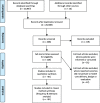Engaging patients to improve quality of care: a systematic review
- PMID: 30045735
- PMCID: PMC6060529
- DOI: 10.1186/s13012-018-0784-z
Engaging patients to improve quality of care: a systematic review
Abstract
Background: To identify the strategies and contextual factors that enable optimal engagement of patients in the design, delivery, and evaluation of health services.
Methods: We searched MEDLINE, EMBASE, CINAHL, Cochrane, Scopus, PsychINFO, Social Science Abstracts, EBSCO, and ISI Web of Science from 1990 to 2016 for empirical studies addressing the active participation of patients, caregivers, or families in the design, delivery and evaluation of health services to improve quality of care. Thematic analysis was used to identify (1) strategies and contextual factors that enable optimal engagement of patients, (2) outcomes of patient engagement, and (3) patients' experiences of being engaged.
Results: Forty-eight studies were included. Strategies and contextual factors that enable patient engagement were thematically grouped and related to techniques to enhance design, recruitment, involvement and leadership action, and those aimed to creating a receptive context. Reported outcomes ranged from educational or tool development and informed policy or planning documents (discrete products) to enhanced care processes or service delivery and governance (care process or structural outcomes). The level of engagement appears to influence the outcomes of service redesign-discrete products largely derived from low-level engagement (consultative unidirectional feedback)-whereas care process or structural outcomes mainly derived from high-level engagement (co-design or partnership strategies). A minority of studies formally evaluated patients' experiences of the engagement process (n = 12; 25%). While most experiences were positive-increased self-esteem, feeling empowered, or independent-some patients sought greater involvement and felt that their involvement was important but tokenistic, especially when their requests were denied or decisions had already been made.
Conclusions: Patient engagement can inform patient and provider education and policies, as well as enhance service delivery and governance. Additional evidence is needed to understand patients' experiences of the engagement process and whether these outcomes translate into improved quality of care.
Registration: N/A (data extraction completed prior to registration on PROSPERO).
Keywords: Health delivery; Health services; Patient engagement; Patient involvement; Quality improvement; Quality of care; Systematic review.
Conflict of interest statement
Ethics approval and consent to participate
Not applicable.
Consent for publication
Not applicable.
Competing interests
The author(s) declare that they have no competing interests. All authors have completed the Unified Competing Interest form at (available on request from the corresponding author) and declare no support from any organization for the submitted work; no financial relationships with any organizations that might have an interest in the submitted work in the previous 3 years; and no other relationships or activities that could appear to have influenced the submitted work.
Publisher’s Note
Springer Nature remains neutral with regard to jurisdictional claims in published maps and institutional affiliations.
Figures


References
-
- Darzi A. High quality care for all: our journey so far. London: Department of Health; 2008.
-
- Ontario Health Quality Council. QMonitor: 2009 report on Ontari’s health system. Toronto: Government of Ontario; 2009.
-
- Institute of Medicine . Crossing the quality chasm: a new health system for the 21st century. Washington, DC: National Academy of Sciences; 2001.
Publication types
MeSH terms
LinkOut - more resources
Full Text Sources
Other Literature Sources
Medical

